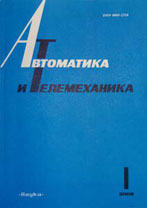|
This article is cited in 1 scientific paper (total in 1 paper)
Robust identification under correlated and non-Gaussian noises: WMLLM procedure
A. S. Poznyak
CINVESTAV-IPN, Mexico City, Mexico
Abstract:
The paper represents the main ideas of Robust Identification Theory, which was initiated by Ya.Z. Tzypkin in 80s of the past century. Here we demonstrate that the parallel application of both the “Whitening Procedure” and the recurrent min-max version of the “Maximum Likelihood Method” (MLLM), guarantees the property of Asymptotic Consistency of this procedure. The information Cramér–Rao inequality is also obtained and it is shown that this combined procedure attains this information bound. This means that for wide class of regular observations of ARX (auto regression with exogenous input) models, there does not exist any other identification algorithm, estimating asymptotically unknown parameters “quicker” then the procedure discussed here, if the distribution of the white noise at the input of the forming filter is known exactly. The main specific feature of this method consists in the possible consideration of external non-Gaussian white noise (defined on the given class of admissible distributions) in the input of the forming filter, making the noise sequence, affecting the input of ARX-dynamics, non-Gaussian, and correlated. The almost sure convergence as well as the Asymptotic Normality of the estimation error are formulated. If the information on the input of the forming filter is uncertain, that is, when the distribution belongs to a given class, then the Huber’s approach is applied using the robust version of MLLM.
Keywords:
robust identification, whitening procedure, recurrent ML, non-Gaussian white noise, Cramér–Rao inequality.
Received: 24.07.2018
Revised: 08.10.2018
Accepted: 08.11.2018
Citation:
A. S. Poznyak, “Robust identification under correlated and non-Gaussian noises: WMLLM procedure”, Avtomat. i Telemekh., 2019, no. 9, 91–111; Autom. Remote Control, 80:9 (2019), 1628–1644
Linking options:
https://www.mathnet.ru/eng/at15343 https://www.mathnet.ru/eng/at/y2019/i9/p91
|

|




 Contact us:
Contact us: Terms of Use
Terms of Use
 Registration to the website
Registration to the website Logotypes
Logotypes








 Citation in format
Citation in format 
